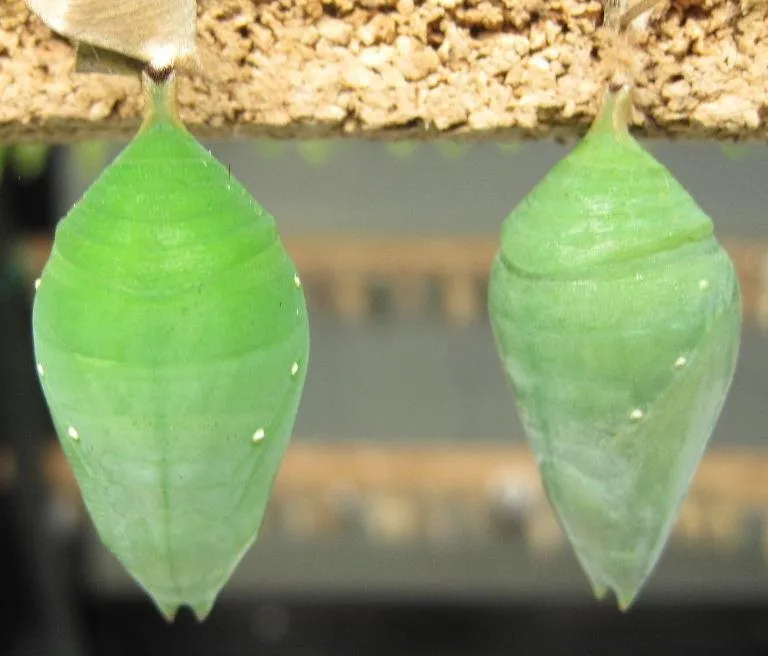The Allure of Morpho Butterflies
Morpho butterflies, with their iridescent wings, are among the most captivating creatures in the insect world. Their brilliant blue hues, a result of the refraction of light on microscopic scales, make them a spectacle to behold. Found primarily in the rainforests of Central and South America, these butterflies are not just beautiful; they are also fascinating subjects for scientific study. The Morpho butterfly has a significant role in its ecosystem. Their presence indicates a healthy environment, which is why they are so important. Additionally, the fact that they can change the color of their wings, attracts scientists to research on the Morpho butterflies. Their beauty is matched by a complex biology, making them a compelling focus for research, including the potential applications of CRISPR technology.
Morpho Butterfly Facts
Morpho butterflies are known for their vibrant, iridescent wings, the most striking feature. These colors are not due to pigments but to structural coloration, where microscopic structures on the wings scatter light. They spend most of their time in the rainforest canopy, only descending to feed on rotting fruit, tree sap, and fungi. The lifespan of a Morpho butterfly is relatively short, typically a few months in the adult stage. Morpho butterflies have a fascinating life cycle, which begins as an egg laid on a host plant. The caterpillar that hatches from the egg feeds voraciously, growing and molting several times before forming a chrysalis. Inside the chrysalis, the caterpillar undergoes a complete metamorphosis, transforming into the beautiful butterfly we recognize. The butterflies are an essential part of their ecosystem. They are an indicator of a healthy environment and play a role in pollination.
The Morpho Butterfly’s Habitat

The natural habitat of Morpho butterflies is the lush, humid environment of tropical rainforests. The rainforests provide the necessary conditions for their survival, including the right host plants for their caterpillars and access to food sources for the adults. These butterflies thrive in the canopy of the rainforests, where sunlight filters through the dense foliage. The environment provides cover from predators and the conditions necessary for them to reproduce. The preservation of their habitat is key to the conservation of these beautiful insects. Deforestation, habitat loss, and climate change pose a significant threat to the Morpho butterfly population, emphasizing the importance of conservation efforts. Maintaining and restoring their habitats will also provide other benefits, such as the preservation of biodiversity and the mitigation of climate change.
The Morpho Butterfly’s Life Cycle
The life cycle of a Morpho butterfly, like all butterflies, is a fascinating process of metamorphosis. It begins with the female laying eggs on specific host plants. These eggs hatch into caterpillars, which are the larval stage. The caterpillars are voracious eaters, growing and molting several times as they consume the leaves of their host plants. The caterpillar then transforms into a chrysalis. This is a crucial stage, as the caterpillar undergoes a complete transformation. Inside the chrysalis, the caterpillar’s body breaks down and reorganizes itself into the form of a butterfly. The adult butterfly emerges from the chrysalis, ready to reproduce. The butterfly then seeks a mate, lays eggs, and the cycle begins again. This life cycle is a delicate balance of environmental factors and genetic programming. Understanding it is key to appreciating the beauty and complexity of these insects.
Understanding CRISPR Technology
CRISPR-Cas9, often simplified to CRISPR, is a revolutionary gene-editing technology. It allows scientists to precisely modify DNA sequences. CRISPR technology is derived from a natural defense mechanism found in bacteria, where it is used to protect against viruses. CRISPR technology is becoming widely known, due to the advancements in science. The CRISPR system is straightforward to use. It involves a guide RNA that matches the target DNA sequence and a Cas9 enzyme, which acts as molecular scissors, cutting the DNA at the precise location. Once the DNA is cut, the cell’s natural repair mechanisms kick in, allowing scientists to either disrupt the gene or insert a new sequence. CRISPR’s efficiency and ease of use have made it a powerful tool in various fields. These include medicine, agriculture, and basic research, opening up new possibilities for treating diseases, enhancing crop yields, and understanding biological processes.
What is CRISPR

CRISPR, or Clustered Regularly Interspaced Short Palindromic Repeats, is a gene-editing technology. It allows scientists to make precise changes to DNA. The technology has its roots in the natural defense mechanisms of bacteria, where it is used to combat viral infections. It uses a guide RNA molecule and the Cas9 enzyme to target and edit DNA. CRISPR is a powerful and versatile tool. It offers a level of precision and control over gene editing that was not previously possible. This has led to breakthroughs in many areas of science, including medicine and agriculture. CRISPR’s accessibility and ease of use have made it a technology that is transforming biological research. CRISPR is also creating important ethical discussions about its use and its impact on society.
How CRISPR Works
The CRISPR-Cas9 system works through a combination of molecular components that target and edit specific DNA sequences. The process begins with the design of a guide RNA (gRNA), which is a short RNA sequence that is complementary to the DNA sequence scientists want to modify. This gRNA guides the Cas9 enzyme to the precise location in the genome. The Cas9 enzyme, derived from bacteria, acts as molecular scissors, cutting the DNA at the targeted site. Once the DNA is cut, the cell’s natural repair mechanisms take over. The cell can either disrupt the gene by introducing small insertions or deletions or use a provided template DNA to repair the break, effectively changing the gene sequence. The beauty of CRISPR lies in its simplicity and precision. It allows scientists to target almost any gene with relative ease, making it a transformative tool in many fields.
The Science Behind CRISPR
The science behind CRISPR involves a sophisticated interplay of molecular biology and genetics. At its core, CRISPR relies on the principle of complementary base pairing, where the guide RNA (gRNA) targets the specific DNA sequence. The gRNA is designed to match the target sequence, ensuring that the Cas9 enzyme is directed to the right location. The Cas9 enzyme, a type of protein, then cuts the DNA, creating a double-strand break. The cell’s DNA repair mechanisms then become active. Non-homologous end joining (NHEJ) can cause gene disruption by introducing small mutations. Alternatively, homology-directed repair (HDR) can use a provided DNA template to insert a new sequence. These processes allow scientists to precisely alter genes. CRISPR technology leverages the power of natural biological processes. Understanding the details of these mechanisms is essential for scientists. The science behind CRISPR continues to evolve, with new developments constantly improving the technology’s efficiency and accuracy.
CRISPR and Morpho Butterflies

The application of CRISPR technology to Morpho butterflies opens exciting possibilities in understanding their biology and potentially enhancing their conservation. Scientists can use CRISPR to study the genes responsible for the Morpho butterfly’s vibrant colors. They can also study their wing patterns and other unique characteristics. CRISPR allows for specific genetic modifications. It could lead to a better understanding of the development and evolution of these insects. The research could also enhance the conservation efforts by gaining insights into the factors that affect their survival in the wild. By using CRISPR, scientists can also explore how the environment impacts the butterflies’ colors and patterns. These studies are important for a number of reasons. Morpho butterflies are indicators of a healthy environment. Studying them can provide important information about the effects of environmental changes.
Fact 1 Morpho Butterfly Color and CRISPR
One exciting application of CRISPR is in studying the genetic basis of the Morpho butterfly’s iridescent blue color. Scientists can use CRISPR to target and modify genes that control the production of pigments and the structure of the wing scales. These scales are what creates the iridescence. By changing these genes, researchers can learn about the precise mechanisms behind the color. This could reveal how the butterfly’s color changes across different environments. It could help understand the evolution of this remarkable feature. CRISPR technology allows for precise control over gene expression. This will help with the study of the interplay between genes and the environment, and how it influences the appearance of the Morpho butterfly’s wings.
Fact 2 Morpho Butterfly and CRISPR Research
CRISPR is also used to study other aspects of Morpho butterfly biology. Scientists may investigate genes that affect the butterfly’s wing patterns, behavior, and even its interactions with the environment. Using CRISPR, researchers can create targeted mutations in these genes and observe the resulting changes. This provides valuable information on the function of these genes and the development of the butterfly. CRISPR research can also help in identifying genes that are essential for the butterfly’s survival in its natural habitat. This information is crucial for conservation efforts. CRISPR makes it possible to understand the complex relationships between genes, environment, and behavior. This will help us protect and appreciate these amazing insects.
Fact 3 Genetic Modification of Morpho Butterflies

Genetic modification of Morpho butterflies through CRISPR is a powerful tool for both research and potential conservation. Scientists could modify the color or pattern of the wings to study their function. CRISPR can also be used to introduce genes. This can help with improving the butterfly’s resilience to climate change or resistance to diseases. However, the genetic modification of Morpho butterflies brings up many challenges. This includes the difficulty of working with insects, the need to understand the complex genetics, and the importance of ethical considerations. The scientific community is addressing these issues. The goal is to ensure that these technologies are used responsibly. Scientists hope to use CRISPR to enhance the understanding and protection of these insects.
Fact 4 CRISPR Impact on Morpho Butterfly
The impact of CRISPR on Morpho butterfly research is already significant. CRISPR enables scientists to study the function of genes more precisely. It also helps them understand how these genes affect the development, behavior, and survival of the butterfly. This research provides a deeper understanding of the biology of these insects. It also helps us understand the relationship between the environment and genetics. CRISPR research has advanced our understanding of evolution. In the future, CRISPR could also lead to a greater appreciation and conservation of the Morpho butterflies. By understanding these butterflies and the dangers to them, we can protect them from climate change and habitat loss.
Fact 5 Future Applications of CRISPR on Morpho Butterflies
The future applications of CRISPR on Morpho butterflies are vast and promising. Researchers are exploring the potential to use CRISPR for conservation efforts. This could include enhancing the butterflies’ resilience to climate change. Another use could be the introduction of disease-resistant genes. CRISPR could also be used to study the impact of environmental changes on the butterflies. The aim is to protect them from the effects of deforestation. Researchers also aim to learn about the genetics of the butterflies. This may lead to a better understanding of the insects and their unique colors. As CRISPR technology continues to advance, we can expect even more amazing discoveries and innovations in the field of Morpho butterfly research and conservation. These innovations will help protect these amazing insects.
CRISPR in the Realm of Tarantulas

While the application of CRISPR in Morpho butterflies is promising, the technology also holds potential in the study of tarantulas, though it presents unique challenges. Tarantulas are complex organisms, and the genetic manipulation is a bit more difficult than in butterflies. Researchers are still working to develop effective CRISPR protocols for tarantulas, including techniques for the delivery of the CRISPR components into their cells. Despite these hurdles, scientists are exploring the use of CRISPR to understand the genes that control various aspects of tarantula biology. Some research involves understanding the genes for venom production, which could offer insights into the development of new antivenoms or even novel drugs. Others explore the genetics of tarantula coloration, behavior, and development. This research could give insights into these fascinating creatures.
The Challenges of CRISPR in Tarantulas
The application of CRISPR in tarantulas is difficult because of several challenges. The most difficult challenge is the size and complexity of the tarantula genome, and the difficulty of gene editing. The delivery of CRISPR components into tarantula cells is a delicate task. Scientists are still developing effective methods to get these components into the tarantula’s cells, and ensure that the CRISPR system will work. The tarantula’s slow reproductive cycle also limits the speed at which experiments can be conducted. Researchers need to perfect and implement techniques to use CRISPR in tarantulas. As technology improves, CRISPR could become a powerful tool for understanding tarantulas.
The Potential of CRISPR in Tarantulas
CRISPR holds significant potential in the study of tarantulas. Scientists could use CRISPR to study the tarantula’s venom production. They could then investigate the genes that influence the venom’s toxicity, which would result in the development of new antivenoms. CRISPR could also be used to study the tarantula’s coloration and behavior. The researchers could manipulate the genes that control these traits and learn about the effects on the tarantula. The potential also extends to conservation efforts, with the possibility of understanding how tarantulas adapt to environmental changes. The ability to modify genes, helps to better understand and protect these fascinating creatures. CRISPR in tarantula research holds immense promise.
Ethical Considerations of CRISPR

The use of CRISPR technology brings up many important ethical considerations. It is important to address how to use the technology responsibly. One of the main concerns is the potential for unintended consequences. Scientists must ensure that any changes they make to an organism’s genes do not have unexpected effects on the environment. The long-term effects of CRISPR gene editing are also a major concern. CRISPR in tarantulas and Morpho butterflies is also subject to ethical guidelines. The ethical considerations in CRISPR research is that it is important to carefully consider how the technology is used. There is also a need to ensure transparency in research and to protect animal welfare. Careful consideration of the ethical implications of CRISPR is key to maximizing its benefits while minimizing the risks.
The Role of Ethics
Ethics plays a critical role in guiding the use of CRISPR technology. Ethics should ensure that research is conducted responsibly. Ethical considerations include the need to obtain informed consent from any affected organisms. It must be a process that minimizes harm and maximizes benefits. Ethical guidelines also address transparency in research. The goal is to make sure that scientific findings are shared openly and that the public has access to the information. Ethical frameworks also provide guidance on the potential environmental impacts of CRISPR. This includes assessing the risks of releasing genetically modified organisms into the wild. Ethics is essential for guiding the development and use of CRISPR technology. It helps to ensure that the technology is used for good.
The Future of CRISPR
The future of CRISPR technology is promising. It will revolutionize various fields, and provide new opportunities for scientific advancement. As technology continues to develop, CRISPR is becoming more efficient and accurate, opening the door to new applications. In the field of medicine, CRISPR is being used to develop new treatments for genetic diseases. In agriculture, CRISPR is being used to improve crop yields and make crops resistant to pests and diseases. The use of CRISPR is expanding into new areas of research. This includes research on the Morpho butterfly and tarantulas. The future of CRISPR is full of potential, and there are many potential discoveries. As scientists continue to explore the possibilities, CRISPR will continue to have an impact on science.
